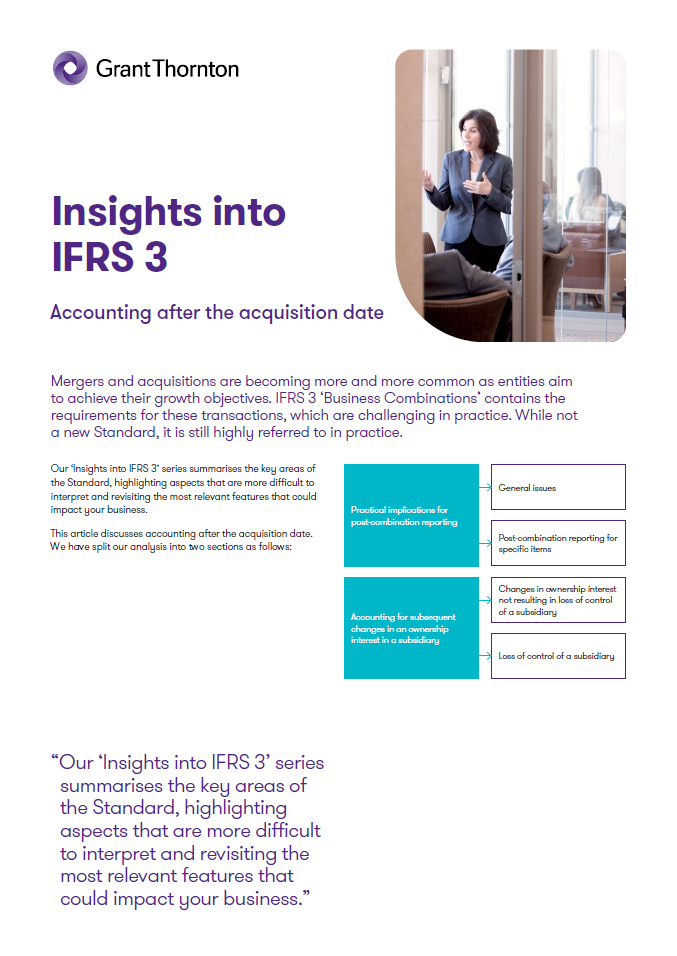-
Why Grant Thornton
Whether you’re growing in one market or many, looking to operate more effectively, managing risk and regulation, or realising stakeholder value, our firms can help.
-
Culture and experience
Grant Thornton’s culture is one of our most valuable assets and has steered us in the right direction for more than 100 years.
-
Global scale and capability
Beyond global scale, we embrace what makes each market unique, local understanding on a global scale.
-
Join our network
In a world that wants more options for high quality services, we differentiate in the market to grow sustainably in today’s rapidly changing environment.
-
Leadership governance and quality
Grant Thornton International Ltd acts as the coordinating entity for member firms in the network with a focus on areas such as strategy, risk, quality monitoring and brand.
-
Africa
24 member firms supporting your business.
-
Americas
31 member firms, covering 44 markets and over 20,000 people.
-
Asia-Pacific
19 member firms with nearly 25,000 people to support you.
-
Europe
53 member firms supporting your business.
-
Middle East
8 member firms supporting your business.
-
Business consulting services
Our business consulting services can help you improve your operational performance and productivity, adding value throughout your growth life cycle.
-
Business process solutions
We can help you identify, understand and manage potential risks to safeguard your business and comply with regulatory requirements.
-
Business risk services
The relationship between a company and its auditor has changed. Organisations must understand and manage risk and seek an appropriate balance between risk and opportunities.
-
Cybersecurity
As organisations become increasingly dependent on digital technology, the opportunities for cyber criminals continue to grow.
-
Forensic services
At Grant Thornton, we have a wealth of knowledge in forensic services and can support you with issues such as dispute resolution, fraud and insurance claims.
-
Mergers and acquisitions
We work with entrepreneurial businesses in the mid-market to help them assess the true commercial potential of their planned acquisition and understand how the purchase might serve their longer-term strategic goals.
-
Recovery and reorganisation
Workable solutions to maximise your value and deliver sustainable recovery.
-
Transactional advisory services
We can support you throughout the transaction process – helping achieve the best possible outcome at the point of the transaction and in the longer term.
-
Valuations
We provide a wide range of services to recovery and reorganisation professionals, companies and their stakeholders.
-
Sustainability advisory
We can assist you with a variety of sustainability advice depending on your needs, ranging from initial strategy development, reporting and compliance support, through to carbon measurement and management.

-
IFRS
At Grant Thornton, our IFRS advisers can help you navigate the complexity of financial reporting from IFRS 1 to IFRS 17 and IAS 1 to IAS 41.
-
Audit quality monitoring
Having a robust process of quality control is one of the most effective ways to guarantee we deliver high-quality services to our clients.
-
Global audit technology
Our global assurance technology platform provides the ability to conduct client acceptance, consultations and all assurance and other attestation engagements.
-
Sustainability assurance
Our sustainability assurance services are based on our global network of specialists, helping you make more efficient decisions for the good of your organisation.

-
Corporate and business tax
Our trusted teams can prepare corporate tax files and ruling requests, support you with deferrals, accounting procedures and legitimate tax benefits.
-
Direct international tax
Our teams have in-depth knowledge of the relationship between domestic and international tax laws.
-
Global mobility services
Through our global organisation of member firms, we support both companies and individuals, providing insightful solutions to minimise the tax burden for both parties.
-
Indirect international tax
Using our finely tuned local knowledge, teams from our global organisation of member firms help you understand and comply with often complex and time-consuming regulations.
-
Transfer pricing
The laws surrounding transfer pricing are becoming ever more complex, as tax affairs of multinational companies are facing scrutiny from media, regulators and the public
-
Africa tax desk
A differentiating solution adapted to the context of your investments in Africa.
-
Sustainability tax
Through our sustainability tax advisory services, we can advise how environmental taxes, incentives, and obligations can impact your progress, requiring alignment with governmental and legislative pressures.

-
 Banking Holding banking to account: the real diversity and inclusion pictureWe explore how the banking sector can continue to attract, retain and nurture women to build a more diverse and inclusive future.
Banking Holding banking to account: the real diversity and inclusion pictureWe explore how the banking sector can continue to attract, retain and nurture women to build a more diverse and inclusive future. -
 Sustainability From voluntary to mandatory ESG: How banks can future-proof their operationsAs we move from voluntary ESG initiatives to mandatory legislation, we explore what the banking sector needs to prioritise.
Sustainability From voluntary to mandatory ESG: How banks can future-proof their operationsAs we move from voluntary ESG initiatives to mandatory legislation, we explore what the banking sector needs to prioritise. -
 IFRS IFRS 9 - Audit of Expected Credit LossesGPPC releases The Auditor’s response to the risks of material misstatement posed by estimates of expected credit losses under IFRS 9
IFRS IFRS 9 - Audit of Expected Credit LossesGPPC releases The Auditor’s response to the risks of material misstatement posed by estimates of expected credit losses under IFRS 9 -
 growthiQ Steering your company to long-term successHistory has something important to tell us about the difficulties of steering a business to long-term success – through seismic shifts in technology, consumer demands and product development. With that in mind it’s unsurprising that over half the world’s largest companies in the early 1900s had shut their doors by the late 1990s. Some, however, have endured.
growthiQ Steering your company to long-term successHistory has something important to tell us about the difficulties of steering a business to long-term success – through seismic shifts in technology, consumer demands and product development. With that in mind it’s unsurprising that over half the world’s largest companies in the early 1900s had shut their doors by the late 1990s. Some, however, have endured.
-
 International Financial Reporting Standards Implementation of IFRS 17 ‘Insurance Contracts’The auditor’s response to the risks of material misstatement arising from estimates made in applying IFRS 17 ‘Insurance Contracts’
International Financial Reporting Standards Implementation of IFRS 17 ‘Insurance Contracts’The auditor’s response to the risks of material misstatement arising from estimates made in applying IFRS 17 ‘Insurance Contracts’ -
 IFRS Get ready for IFRS 17After twenty years of development the IASB has published IFRS 17 ‘Insurance Contracts’, find out more.
IFRS Get ready for IFRS 17After twenty years of development the IASB has published IFRS 17 ‘Insurance Contracts’, find out more.
-
 Global business pulse - industry analysis Mid-market recovery spreads to more industriesThe index results for 13 key industries of the mid-market reveals a very uneven recovery from COVID-19
Global business pulse - industry analysis Mid-market recovery spreads to more industriesThe index results for 13 key industries of the mid-market reveals a very uneven recovery from COVID-19 -
 Global business pulse - industry analysis A very uneven recovery across industriesThe index results for 13 key industries of the mid-market reveals a very uneven recovery from COVID-19
Global business pulse - industry analysis A very uneven recovery across industriesThe index results for 13 key industries of the mid-market reveals a very uneven recovery from COVID-19 -
 Global business pulse - Sector analysis Clear patterns of damage from COVID-19 across the industriesThe index results for 12 key sectors of the mid-market reveal just how much or little the various parts of the economy were impacted by COVID-19.
Global business pulse - Sector analysis Clear patterns of damage from COVID-19 across the industriesThe index results for 12 key sectors of the mid-market reveal just how much or little the various parts of the economy were impacted by COVID-19. -
 Not for profit Mission: possible – putting impact at the heart of charityGlobal charitable continues to decline and charity leaders are increasingly looking at their own unique impact journey.
Not for profit Mission: possible – putting impact at the heart of charityGlobal charitable continues to decline and charity leaders are increasingly looking at their own unique impact journey.
-
 Access to finance Raise finance to invest in changePrepare your business to raise finance to invest in change.
Access to finance Raise finance to invest in changePrepare your business to raise finance to invest in change. -
 Private equity firms Private equity in the mid-market: reshaping strategies for 2021When the global COVID-19 pandemic stormed across the globe in early 2020, the private equity sector was hit hard but deals are coming back to the market.
Private equity firms Private equity in the mid-market: reshaping strategies for 2021When the global COVID-19 pandemic stormed across the globe in early 2020, the private equity sector was hit hard but deals are coming back to the market. -
 Mid-market businesses Getting ready for private equity investmentOur specialists explore how private equity firms are now working with their portfolios and how the mid-market can benefit from investment.
Mid-market businesses Getting ready for private equity investmentOur specialists explore how private equity firms are now working with their portfolios and how the mid-market can benefit from investment. -
 Mid-market businesses Myth-busting private equityNervous about partnering with Private Equity? We explore some of the common myths we come across when speaking to mid-market businesses about PE investment.
Mid-market businesses Myth-busting private equityNervous about partnering with Private Equity? We explore some of the common myths we come across when speaking to mid-market businesses about PE investment.
-
 Public sector Helping build the government of tomorrow, todayLearn about the Grant Thornton US public sector team.
Public sector Helping build the government of tomorrow, todayLearn about the Grant Thornton US public sector team. -
 Global business pulse - industry analysis Mid-market recovery spreads to more industriesThe index results for 13 key industries of the mid-market reveals a very uneven recovery from COVID-19
Global business pulse - industry analysis Mid-market recovery spreads to more industriesThe index results for 13 key industries of the mid-market reveals a very uneven recovery from COVID-19 -
 Global business pulse - industry analysis A very uneven recovery across industriesThe index results for 13 key industries of the mid-market reveals a very uneven recovery from COVID-19
Global business pulse - industry analysis A very uneven recovery across industriesThe index results for 13 key industries of the mid-market reveals a very uneven recovery from COVID-19 -
 Global business pulse - Sector analysis Clear patterns of damage from COVID-19 across the industriesThe index results for 12 key sectors of the mid-market reveal just how much or little the various parts of the economy were impacted by COVID-19.
Global business pulse - Sector analysis Clear patterns of damage from COVID-19 across the industriesThe index results for 12 key sectors of the mid-market reveal just how much or little the various parts of the economy were impacted by COVID-19.
-
 Industries European Real Estate PodcastJessica Patel, Tax Partner at Grant Thornton UK speaks with tax partners and directors across the network to share their insights on the real estate market and some of the challenges.
Industries European Real Estate PodcastJessica Patel, Tax Partner at Grant Thornton UK speaks with tax partners and directors across the network to share their insights on the real estate market and some of the challenges. -
 Industries European Real Estate PodcastJessica Patel, Tax Partner at Grant Thornton UK speaks with tax partners and directors across the network to share their insights on the real estate market and some of the challenges.
Industries European Real Estate PodcastJessica Patel, Tax Partner at Grant Thornton UK speaks with tax partners and directors across the network to share their insights on the real estate market and some of the challenges. -
 Global business pulse - industry analysis Mid-market recovery spreads to more industriesThe index results for 13 key industries of the mid-market reveals a very uneven recovery from COVID-19
Global business pulse - industry analysis Mid-market recovery spreads to more industriesThe index results for 13 key industries of the mid-market reveals a very uneven recovery from COVID-19 -
 Global business pulse - industry analysis A very uneven recovery across industriesThe index results for 13 key industries of the mid-market reveals a very uneven recovery from COVID-19
Global business pulse - industry analysis A very uneven recovery across industriesThe index results for 13 key industries of the mid-market reveals a very uneven recovery from COVID-19
-

-
 Global business pulse - industry analysis Mid-market recovery spreads to more industriesThe index results for 13 key industries of the mid-market reveals a very uneven recovery from COVID-19
Global business pulse - industry analysis Mid-market recovery spreads to more industriesThe index results for 13 key industries of the mid-market reveals a very uneven recovery from COVID-19 -
 Global business pulse - industry analysis A very uneven recovery across industriesThe index results for 13 key industries of the mid-market reveals a very uneven recovery from COVID-19
Global business pulse - industry analysis A very uneven recovery across industriesThe index results for 13 key industries of the mid-market reveals a very uneven recovery from COVID-19 -
 Retail How retail is positioning for successCOVID-19 provided some hard lessons for the retail industry. It is time to turn those into sustainable and well executed growth strategies in 2021.
Retail How retail is positioning for successCOVID-19 provided some hard lessons for the retail industry. It is time to turn those into sustainable and well executed growth strategies in 2021.
-
 Technology Mid-market tech companies lead the way on diversity and inclusionWe explore how the mid-market tech sector can continue to build and nurture a culture that’s increasingly more diverse and inclusive for women.
Technology Mid-market tech companies lead the way on diversity and inclusionWe explore how the mid-market tech sector can continue to build and nurture a culture that’s increasingly more diverse and inclusive for women. -
 Tax Resetting global tax rules after the pandemicBusinesses are seeing rising challenges, and finance heads are dealing with a range of new measures. To say the next 12 months are critical for businesses is an understatement.
Tax Resetting global tax rules after the pandemicBusinesses are seeing rising challenges, and finance heads are dealing with a range of new measures. To say the next 12 months are critical for businesses is an understatement. -
 TECHNOLOGY International tax reform: the potential impact on the technology industryIn this article, we’ve summarised key elements of the global tax reform proposals, their potential impact on technology industry and advice from our digital tax specialists on what technology companies can do to prepare.
TECHNOLOGY International tax reform: the potential impact on the technology industryIn this article, we’ve summarised key elements of the global tax reform proposals, their potential impact on technology industry and advice from our digital tax specialists on what technology companies can do to prepare. -
 TMT TMT industry: Fully charged or on standby?Our research revealed five key trends that resonated with Technology, Media and Telecoms (TMT) industry leaders around the world. We asked a panel of our experts from UK, US, India Ireland and Germany, to give us their reaction to the findings.
TMT TMT industry: Fully charged or on standby?Our research revealed five key trends that resonated with Technology, Media and Telecoms (TMT) industry leaders around the world. We asked a panel of our experts from UK, US, India Ireland and Germany, to give us their reaction to the findings.
-
 TMT TMT industry: Fully charged or on standby?Our research revealed five key trends that resonated with Technology, Media and Telecoms (TMT) industry leaders around the world. We asked a panel of our experts from UK, US, India Ireland and Germany, to give us their reaction to the findings.
TMT TMT industry: Fully charged or on standby?Our research revealed five key trends that resonated with Technology, Media and Telecoms (TMT) industry leaders around the world. We asked a panel of our experts from UK, US, India Ireland and Germany, to give us their reaction to the findings. -
 Cybersecurity One size fits nothingTechnology companies must adopt a new approach to digital risk: those that successfully develop a reputation for digital trust by demonstrating an unwavering commitment to cyber security and data privacy will be able to carve out a competitive advantage.
Cybersecurity One size fits nothingTechnology companies must adopt a new approach to digital risk: those that successfully develop a reputation for digital trust by demonstrating an unwavering commitment to cyber security and data privacy will be able to carve out a competitive advantage. -
 Technology, media & telecommunications Why it’s time for a 5G reality checkFigures suggest the mobile sector is maturing. While data usage continues to soar, mobile revenues are expected to flatten out over the next few years.
Technology, media & telecommunications Why it’s time for a 5G reality checkFigures suggest the mobile sector is maturing. While data usage continues to soar, mobile revenues are expected to flatten out over the next few years. -
 GrowthiQ Is blockchain right for your business?Blockchain has been seized upon by the financial services sector, where it is playing a crucial role in tracking and authenticating transactions.
GrowthiQ Is blockchain right for your business?Blockchain has been seized upon by the financial services sector, where it is playing a crucial role in tracking and authenticating transactions.
-
 International business Mid-market businesses lifted by rising tide of optimismOptimism among global mid-market business leaders rose to 67% in the first half of this year and they are markedly more optimistic about their prospects with global optimism having increased by 8%.
International business Mid-market businesses lifted by rising tide of optimismOptimism among global mid-market business leaders rose to 67% in the first half of this year and they are markedly more optimistic about their prospects with global optimism having increased by 8%. -
 Global business pulse - industry analysis Mid-market recovery spreads to more industriesThe index results for 13 key industries of the mid-market reveals a very uneven recovery from COVID-19
Global business pulse - industry analysis Mid-market recovery spreads to more industriesThe index results for 13 key industries of the mid-market reveals a very uneven recovery from COVID-19 -
 Hotels COVID-19: Checking in with the hotel industry one year onCOVID-19 provided some hard lessons for the hotel sector. It is time to turn those into sustainable and well executed growth strategies.
Hotels COVID-19: Checking in with the hotel industry one year onCOVID-19 provided some hard lessons for the hotel sector. It is time to turn those into sustainable and well executed growth strategies. -
 Global business pulse - industry analysis A very uneven recovery across industriesThe index results for 13 key industries of the mid-market reveals a very uneven recovery from COVID-19
Global business pulse - industry analysis A very uneven recovery across industriesThe index results for 13 key industries of the mid-market reveals a very uneven recovery from COVID-19
- By topic
-
Women in Business 2025
For 21 years, the Women in Business report has tracked the proportion of women in senior roles in the mid-market. Progress has been made but with gender equity over 25 years away, that isn’t soon enough.
-
The journey to a sustainable future
The world needs a sustainable mid-market. It’s vital to economies, societies and the planet. Businesses, governments, and other stakeholders must work collaboratively to make sure this vital part of the world economy succeeds.
-
International business: Mid-market growth and expansion
The mid-market looks to international business opportunities for growth.
-
Mid-market optimism tempered by concerns over economic uncertainty
While a record 76% are optimistic about the outlook for their economy over the next 12 months (up two points from Q3 2024), concerns over economic uncertainty also rose four points to 56%, according to Grant Thornton's latest International Business Report (IBR).
-
Women in Business 2025: Impacting the missed generation
The 2025 Women in Business report explores the external pressures and internal drivers that impact gender diversity in senior roles in the mid-market.
-
Women in tech: A pathway to gender balance in top tech roles
Grant Thornton’s 2024 Women in Business data suggests we are far from achieving parity within the mid-market technology sector.
-
Women in leadership: a pathway to better performance
What makes the benefits of gender parity compelling is the impact it can have on commercial performance.
-
Women in Business 2024
2024 marks the 20th year of Women in business where we monitor and measure the proportion of women occupying senior management roles around the world.
-
Women in business: Regional picture
We saw an increase in the percentage of senior management roles held by women, on a global level, but there are some significant regional and country variations.
-
Pathways to Parity: Leading the way
To push towards parity of senior management roles held by women, who leads within an organisation is vital.
-
Generating real change with a long-term focus
The most successful strategy to achieve parity of women in senior management is one which stands alone, independent of an ESG strategy.
-
People at the heart of great business
Businesses have started to put guidelines and incentives in place, focused on driving employees back to the office.
-
Ten considerations for preparing TCFD climate-related financial disclosures
Insights for organisations preparing to implement the International Sustainability Standards Board (ISSB)’s Standards.
-
COP28
COP28 was the first time there has been a global stocktake on progress against the Paris Agreement.
-
Transition Plan Taskforce publishes its final disclosure framework
As organisations in the private sector make commitments and plans to reach net zero, there's a growing need for stakeholders to be able to assess the credibility of their transition plans.
-
Promoting ESG excellence through tax
ESG considerations have never been more important for an organisation’s long-term success, but how can tax be used to add value to an ESG agenda?
-
International business: Mid-market growth and expansion
The mid-market looks to international business opportunities for growth.
-
Top five constraints to international business in the mid-market
Top five major constraints that are testing the mid-market’s ability to grow their businesses internationally.
-
Brand and international marketing – breaking global barriers
Brand has been identified as a key driver of mid-market success when looking to grow and develop international business.
-
The key to international business: Investing in people
How can recruitment and retention help grow international business?
-
Building resilience in international business
Evolving supply chains and trade patterns amid ongoing global uncertainty.
-
Example Financial Statements
General guidance for preparers of financial statements that supports the commitment to high quality, consistent application of IFRS.
-
Insights into IFRS 2
Insights into IFRS 2 summarises the key areas of the Standard, highlighting aspects that are more difficult to interpret and revisiting the most relevant features that could impact your business.
-
IFRS 3
Mergers and acquisitions are becoming more common as entities aim to achieve their growth objectives. IFRS 3 ‘Business Combinations’ contains the requirements for these transactions.
-
IFRS 8
Our ‘Insights into IFRS 8’ series considers some key implementation issues and includes interpretational guidance in certain problematic areas.
-
IFRS 16
Are you ready for IFRS 16? This series of insights will help you prepare.
-
IAS 36
Insights into IAS 36 provides assistance for preparers of financial statements and help where confusion has been seen in practice.
-
IFRS 17
Explaining the key features of the Standard and providing insights into its application and impact.
-
Pillar 2
Key updates and support for the global implementation of Pillar 2.
-
Global expatriate tax guide
Growing businesses that send their greatest assets – their people – overseas to work can face certain tax burdens, our global guide highlights the common tax rates and issues.
-
International indirect tax guide
Navigating the global VAT, GST and sales tax landscape.
-
Global transfer pricing guide
Helping you easily find everything you need to know about the rules and regulations regarding transfer pricing and Country by Country reporting for every country you do business with.

Mergers and acquisitions are becoming more and more common as entities aim to achieve their growth objectives. IFRS 3 ‘Business Combinations’ contains the requirements for these transactions, which are challenging in practice. While not a new Standard, it is still highly referred to in practice.

This article discusses accounting after the acquisition date. We have split our analysis into two sections as follows:
- General issues
- Post-combination reporting for specific items
- Changes in ownership interest not resulting in loss of control of a subsidiary
- Loss of control of a subsidiary
Practical implications for post-combination reporting
General issues
The parent entity is required to undertake a number of practical steps in order to prepare financial statements that include the acquired subsidiary (both for the first post-combination reporting date and subsequently). The following table highlights some key accounting policy and procedure considerations that should be addressed in the initial consolidation of the acquired subsidiary, and in the subsequent accounting by the subsidiary as part of the group. The parent will also need to consider the impact on the subsidiary's reporting systems, processes and procedures to ensure the appropriate consolidation information is captured.
Please note that the following lists are not exhaustive, and there may be other matters specific to each business combination that also need to be considered.
| Accounting requirements | Matters for consideration |
|---|---|
|
Align the acquired subsidiary's accounting policies with those used for the consolidated financial statements
|
Review the consistency of the acquired subsidiary's accounting policies and estimates with those of the parent's.
Areas where differences often arise include:
- revenue recognition policies (this is especially relevant if the subsidiary has been applying a local GAAP prior to the combination)
- inventory valuation and capitalisation policies
- depreciation methods for property, plant and equipment and intangibles, including estimates of useful lives and residual values
- accounting policy options (for example cost model or revaluation model for property, plant & equipment)
Develop accounting policies and estimates for transaction types, assets and liabilities that are new to the group and not addressed in existing policies. Note if the acquirer does not have a policy for certain transaction types, they do not necessarily have to adopt the acquiree’s policy. They can develop their own policy or adopt the acquiree’s.
|
|
Align the accounting period of the subsidiary with that of the parent
Note: IFRS 10 ‘Consolidated Financial Statements’ allows a parent to use a subsidiary's financial statements prepared at a different reporting date. However, the difference in the reporting dates cannot exceed three months. In addition, the parent is required to make adjustments to account for the effects of significant transactions or events between the reporting dates of the parent and the subsidiary.
|
The financial statements of the acquired subsidiary, used by the parent to prepare consolidated financial statements, should cover the same financial period as that of the parent/existing group financial statements
- when the accounting periods are different, the parent should change the subsidiary's year-end to match its own year-end if practicable
- if alignment is impracticable, the parent needs to implement procedures to make adjustments for the effects of significant transactions or events between the respective year-ends of the parent and the subsidiary. In effect preparing additional financial statements for use in the consolidation.
|
|
Classify and designate assets acquired and liabilities assumed
|
The subsidiary's assets and liabilities should be classified and designated based on their contractual terms, economic conditions and the parent's accounting policies
This designation is done on the basis of the above factors as at the acquisition date. There is however an exception for leases in which the acquirer is acting as a lessor. These contracts shall be classified as operating or finance leases based on the contractual terms and other factors as at the inception of the contract, or at the date of any subsequent modification of contractual terms that would lead to a change in classification (which may be the acquisition date)
See ‘Insights into IFRS 3 – Specific recognition and measurement provisions’ for further information.
|
|
Allocate goodwill to cash generating units (CGUs) or groups of CGUs and test for impairment (see IAS 36 ‘Impairment of Assets’)
|
Any goodwill arising as a result of an acquisition must be allocated to a CGU (or group of CGUs)
Before the end of the reporting period, test any CGU to which goodwill is allocated for impairment
Note that any goodwill arising from the acquisition of a foreign operation along with any FV adjustments to assets or liabilities acquired, are treated as assets and liabilities of the foreign operation and therefore need to be recognised in the functional currency of the foreign operation and translated at closing rates in accordance with IAS 21 ‘The Effects of Changes in Foreign Exchange Rates’
When the initial accounting for the business combination is incomplete as of the first reporting date (see Insights into IFRS 3 - Business combinations where the accounting is incomplete at the reporting date), and allocation of goodwill also cannot be completed, the parent:
- discloses the amount of any unallocated goodwill including the reason why such allocation is not yet completed
- completes the initial allocation of goodwill before the end of the reporting period beginning after the acquisition date
- may also need to consider whether the acquired goodwill should be tested for impairment in the current annual period or the following one, depending on whether the annual impairment testing date has passed. If some or all of the goodwill allocated to a CGU resulted from an acquisition during the current period, that CGU should be tested for impairment in the current period, however when the allocation has not been completed management may need to consider if they are able to perform the test based on provisional amounts and/or allocation.
|
|
Update segment reporting disclosures
|
A parent that applies IFRS 8 ‘Operating Segments’ needs to determine the impact of the acquisition on its segment disclosures. It may result in a new reportable segment, an addition to an existing reportable segment or part of a non-reportable segment (which may cause such a segment to exceed the quantitative threshold for reporting)
Under IFRS 8, changes in segment disclosures are triggered when a change is made in the component information reported to the chief operating decision maker.
|
Post-combination reporting for specific items
IFRS 3 is not intended to provide guidance on the subsequent measurement and accounting of items recognised in a business combination. In general, an acquirer shall measure and account for assets acquired, liabilities assumed or incurred, and equity instruments issued in a business combination in accordance with other applicable IFRSs depending on the nature of those items.
However for a limited number of items, specific guidance is provided on how they should be subsequently accounted for, as follows. You can also refer to our article ‘Insights into IFRS 3 – Specific recognition and measurement provisions’.
| Asset or liability | Specific IFRS 3 guidance |
|---|---|
|
Reacquired rights (eg A right previously granted to the acquiree to use the acquirers trade name)
|
Amortised over the remaining contractual period of the original contract, excluding any renewal period
If the reacquired right is subsequently sold to a third party, the carrying amount of the intangible asset is included in the determination of the gain or loss on sale.
|
|
Contingent liabilities
|
After initial recognition and until the liability is settled, cancelled or expires, contingent liabilities shall be measured at the higher of:
- the amount that would be recognised in accordance with IAS 37 ‘Provisions, Contingent Liabilities and Contingent Assets’ and
- the amount initially recognised less, if appropriate, cumulative amortisation recognised in accordance with IFRS 15 ‘Revenue from Contracts with Customers’
This requirement does not apply to contracts accounted for in accordance with IFRS 9 ‘Financial Instruments’.
|
|
Indemnification assets (recognised as a result of contractual indemnification provided to the acquirer)
|
Any recognised indemnification asset is subsequently measured at each reporting date on the same basis as the indemnified liability or asset, subject to any contractual limitations on its amount. If the indemnification asset is not subsequently measured at fair value, the valuation used should consider management's assessment of its collectability
The indemnification asset is only derecognised when the acquirer collects, sells or otherwise loses the right to the asset.
|
|
Contingent consideration
|
Changes in the fair value of contingent consideration (other than measurement period adjustments – see ‘Insights into IFRS 3 – Consideration transferred’) are accounted for as follows:
- if classified as equity – not remeasured and subsequent settlement reported in equity
- if classified as an asset or liability and within the scope of IFRS 9 - remeasured at fair value through profit or loss in accordance with IFRS 9
- if classified as an asset or liability and not within the scope of IFRS 9 – remeasured at fair value through profit or loss.
|
The following examples illustrate aspects of the guidance that can be found in IFRS 3:
Example 1 – Contingent consideration liability
Entity X acquired Entity Y on 31 December 20X1. The purchase agreement included a contingent consideration clause that requires Entity X to issue an additional number of shares equivalent to CU100,000 if the average profits of Entity Y in 20X2 and 20X3 exceed a target level. On the acquisition date, the fair value of the contingent consideration was determined to be CU36,281 based on an assumed discount rate and a 40% probability that Entity Y will achieve its profit target.
Subsequent events information:
- in 20X2, Entity Y's performance exceeds forecasts and at 31 December 20X2, Entity X considers that it is 80% probable that the profit target will be achieved
- on 31 December 20X3, Entity Y has achieved its target. The additional shares are issued on 7 Jan 20X4. The fair value of Entity X's shares on that date is CU16
Analysis
In this situation, the contingent consideration arrangement requires the issuance of a variable number of shares equal to a fixed monetary amount. Accordingly, it is classified as a liability at the acquisition date and is remeasured at each reporting date until settlement or expiry.
At 31 December 20X2, the fair value of the contingent consideration is determined to be CU76,190. The change in the estimate results from changed circumstances during 20X2 (Y's performance was better than anticipated) and the passage of time rather than arising from additional information relating to conditions at the acquisition date. Consequently, the change in fair value of CU39,909 (CU76,190 - CU36,281) is recognised in profit or loss.
At 31 December 20X3, the recorded liability is increased to CU100,000 by recording an additional expense of CU23,810 (CU100,000 - CU76,190).
On 7 January 20X4, 6,250 shares (CU100,000 / CU16 per share) are issued to settle the liability.
Example 2 – Contingent liability with a related indemnification asset
As part of its acquisition of Entity X, Entity W assumed a contingent liability in respect of a third-party litigation. The former owner of Entity X agreed to reimburse Entity W for the losses from the litigation up to CU100. On the acquisition date, Entity W concludes that the lawsuit gives rise to a present obligation and determines that the acquisition date fair value of the contingent liability is CU40. In accounting for the business combination, Entity W recognises a contingent liability of CU40.
At the same time, Entity W recognises a CU40 indemnification asset for the former owner's promise to reimburse up to CU100. The indemnification asset is measured on the same basis as the related contingent liability. Note we have assumed that there is no uncertainty about the recoverability of the indemnification asset.
At the next reporting date, Entity W determines that the amount that would be recognised under IAS 37 for the contingent liability is CU120, based on developments in the case after the acquisition date. The liability measured in accordance with IAS 37 is the best estimate of the expenditure required to settle the contingent liability at the end of the reporting period.
Analysis
The CU120 exceeds the amount recognised at acquisition, so Entity W remeasures the recorded contingent liability to CU120. Entity W also recognises an increase in the value of the indemnification asset, measured on the same basis as the contingent liability. However, the asset is capped at the CU100 promised by Entity X's former owner. A net expense of CU20 is recognised in profit or loss.
Accounting for subsequent changes in an ownership interest in a subsidiary
A change in the parent's ownership interest in a subsidiary may result from a purchase or sale of shares by the parent or from transactions between the subsidiary and non-controlling interests.
This section discusses the accounting for changes in ownership interests that:
- do not result in loss of control of the subsidiary
- do result in loss of control of the subsidiary
The accounting for increases in ownership which result in the gaining of control of a subsidiary have been discussed in our article Insights into IFRS 3 – Recognising and measuring goodwill or gain from a bargain purchase.
Changes in ownership interest that do not result in loss of control
Non-controlling interests (NCI) in a subsidiary are presented as a separate component of equity in the consolidated statement of financial position. Consequently, changes in a parent's ownership interest in a subsidiary that do not result in loss of control are accounted for as equity transactions.
Parent's accounting treatment:
- no gain or loss is recognised when the parent sells shares in the subsidiary (ie increasing NCI)
- a parent’s purchase of additional shares in the subsidiary (ie reducing NCI) does not result in additional goodwill or other adjustments to the initial accounting for the business combination
- in both situations, the carrying amount of the parent’s equity and NCI's share of equity is adjusted to reflect changes in their relative ownership interest in the subsidiary. Any difference between the amount of NCI adjustment and the fair value of the consideration received or paid is recognised in equity, attributed to the parent (this can be retained earnings, or another component of equity)
- the parent should also take the following into consideration:
- the allocated amounts of accumulated other comprehensive income (OCI) (including cumulative exchange differences relating to foreign operations) are adjusted to reflect the changed ownership interests of the parent and the NCI. The re-attribution of accumulated OCI is similarly treated as an equity transaction (ie a transfer between the parent and the NCI)
- for a partial disposal of a subsidiary with foreign operations, the parent re-attributes the proportionate share of cumulative exchange differences recognised in OCI to NCI in that foreign operation
- IFRS 10 does not have any specific guidance for costs directly related to changes in ownership interests but, in our view, costs that are incremental should be deducted from equity (consistent with the rules in IAS 32 ‘Financial Instruments: Presentation’ on other types of transaction in the entity's own equity). Other IFRS Accounting Standards do not contain guidance about where in equity this should be deducted from.
The following examples illustrate IFRS 10's requirements. Where relevant, the examples also illustrate how the adjustment to the carrying amount of NCI is determined under the two NCI measurement models (see ‘Insights into IFRS 3 – Recognising and measuring non-controlling interest’).
Example 3 – Parent sells shares in a subsidiary
Entity A acquired 80% of Entity B in 20X6. On 1 January 20X9, Entity A sells Entity B shares equivalent to 20% of Entity B's outstanding shares for CU260. On that date, the carrying value of Entity B's net assets in the consolidated financial statements, excluding goodwill, amounted to CU900. Goodwill measured using the fair value and proportionate interest model amounts to CU230 and CU200, respectively. Entity A's recorded goodwill is not impaired. Entity B has no accumulated OCI. After the sale, Entity A still has a 60% interest in Entity B and continues to control its operations.
Analysis
Adjustments to NCI and equity in Entity A:
| NCI at fair value model CU |
NCI at proportionate interest model CU |
|
|---|---|---|
|
Carrying value of Entity B's net assets
|
900
|
900
|
|
Goodwill recognised at acquisition
|
230
|
200
|
|
Carrying amount - 1 January 20X9
|
1,130
|
1,100
|
|
Cash consideration received
|
260
|
260
|
|
Less additional NCI to be recognised (20% of carrying amount)
|
(226)
|
(220)
|
|
Amount to be credited to parent's equity
|
34
|
40
|
The choice of recording NCI either using the fair value or proportionate interest model only applies on the acquisition date. Adjustment to NCI is based on NCI's proportionate share of the subsidiary.
Example 4 – Parent acquires additional shares in a subsidiary
Entity C has an 80% interest in Entity D. On the acquisition date, NCI measured using the fair value and proportionate interest model amounts to CU180 and CU150, respectively. On 1 January 20X9, Entity C purchases the remaining 20% interest in Entity D for CU280. Entity C's recorded goodwill is not impaired. From the date of acquisition up to 1 January 20X9, the balance of NCI has increased by CU80 related to the NCI's share of Entity B's profits (CU70) and other comprehensive income (CU10).
Analysis
Adjustments to NCI and equity in Entity C:
| NCI at fair value model CU |
NCI at proportionate interest model CU |
|
|---|---|---|
|
NCI recognised on acquisition date
|
180
|
150
|
|
NCI's accumulated share of profits
|
70
|
70
|
|
NCI's accumulated share of other comprehensive income
|
10
|
10
|
|
Carrying amount of NCI - 1 January 20X9
|
260
|
230
|
|
Cash consideration paid
|
280
|
280
|
|
Less amount debited to NCI (carrying amount)
|
260
|
230
|
|
Amount to be debited to parent's equity
|
20
|
50
|
With the change in ownership interest, the NCI's share of the accumulated OCI is re-attributed to the parent and will be included in the balance of accumulated OCI. Entity C will then record the following entry:
| Debit | Credit | |
|---|---|---|
|
CU
|
CU
|
|
|
Equity
|
10
|
|
|
Accumulated OCI
|
10
|
Accounting for the loss of control of a subsidiary
The loss of control of a subsidiary usually occurs when the parent sells or otherwise transfers its controlling interest in a single transaction or as a result of multiple transactions. However, other events may also result in the loss of control, such as:
- expiration of a contractual agreement that conferred control of the subsidiary
- the subsidiary becomes subject to the control of a government, court, administrator or regulator (without any change in the ownership interest in the subsidiary)
- the subsidiary issues shares that dilutes the parent's controlling interest, or
- contribution of the subsidiary to another entity in exchange for equity interests that does not represent control over that entity
Regardless of the nature of the transaction or event, the loss of control represents a significant economic event that requires the parent to stop consolidating the subsidiary and to recognise any gain or loss.
On the date when control is lost, the parent is required to:
- derecognise the assets (including goodwill) and liabilities of the subsidiary at their carrying amounts
- derecognise the carrying amount of any NCI (including any components of OCI attributable to them)
- recognise the fair value of the consideration received, if any, and any shares distributed as dividends as part of the transaction that resulted in the loss of control
- recognise any investment retained in the former subsidiary at fair value
- reclassify to profit or loss or transfer directly to retained earnings (depending on requirements of other applicable standards), any amount included in OCI, and
- recognise any resulting difference as a gain or loss in profit or loss attributable to the parent.
The following example illustrates how IFRS 10's guidance is applied:
Example 5 - Disposal of a subsidiary while retaining an investment
Entity S acquired its wholly-owned subsidiary, Entity T for CU1,000 on 1 January 20X5. On 31 December 20X9, Entity S sold 90% of its interest in Entity T for cash of CU1,440. On that date, the carrying value of the net assets of Entity T is CU1,350. These net assets include goodwill and a financial asset measured at fair value with changes in fair value recognised in OCI (FVOCI) with a fair value of CU200 and original cost of CU150. Entity T applied the revaluation model of IAS 16 ‘Property, Plant and Equipment’ and has a revaluation reserve balance of CU60. For the purposes of this example, income tax on the gain on sale of the subsidiary is ignored.
Analysis
Accounting for the sale of the subsidiary:
| CU | |
|---|---|
|
Cash consideration
|
1,140
|
|
Fair value of retained investment (financial asset)
|
160
|
|
Subtotal
|
1,600
|
|
Carrying value of net assets
|
1,350
|
|
Gain
|
250
|
|
Add: reserve of debt instruments at FVOCI reclassified to profit or loss
|
50
|
|
Total gain
|
300
|
The fair value of the retained investment is calculated with reference to the fair value of the consideration paid for the controlling interest (CU1,440 x 10% / 90% = CU160). In practice, the fair value of the retained interest may need to be separately determined to exclude any control premium included in the sale price of the controlling interest.
IFRS 10 requires reclassification of any gains or losses previously recognised in OCI (when required by other IFRS) as though the entity had directly disposed of the assets and liabilities. Accordingly, the reserve related to debt instruments held at FVOCI is included in determining the gain on sale of the subsidiary. This represents the gain from original cost to the current FV of the financial asset (CU200 – CU150 = CU50)
Entry to record the sale:
| Debit | Credit | |
|---|---|---|
|
CU
|
CU
|
|
|
Cashv
|
1,140
|
|
|
Financial asset
|
160
|
|
|
Debt instruments at FVOCI reserve
|
50
|
|
|
Identifiable net assets and goodwill
|
1,350
|
|
|
Gain (profit or loss)
|
300
|
Accounting for the subsidiary's revaluation reserve
IFRS 10 also applies to the subsidiary's revaluation reserve related to its property, plant and equipment. IAS 16 requires that the revaluation surplus included in equity may be transferred directly to retained earnings when the asset is derecognised. Upon sale of the subsidiary, any revaluation reserve is then transferred directly to retained earnings and does not form part of the gain on sale of the subsidiary.
Entry to transfer the revaluation reserve to retained earnings:
| Debit | Credit | |
|---|---|---|
|
CU
|
CU
|
|
|
Revaluation reserve
|
60
|
|
|
Retained earnings
|
60
|
Disclosure of the components of the gain on sale:
The gain of CU300 calculated above comprises:
- the gain on sale of the controlling interest and
- the gain on the retained investment.
IFRS 10 requires separate disclosure of these two components, together with the line item in the statement of profit or loss in which the gains or losses are recognised.
This will require a separate calculation of the gain on the retained investment, as follows:
| CU | |
|---|---|
|
Fair value of the retained investment
|
160
|
|
Carrying value (10% of net carrying value of net identifiable asset of CU1,350)
|
(135)
|
|
Gain
|
25
|
|
Plus: share of the debt instruments at FVOCI reserve reclassified to profit or loss (CU50 x 10%)
|
5
|
|
Gain on retained investment
|
30
|
The total gain recorded by Entity S comprises:
| CU | |
|---|---|
|
Gain on disposal of subsidiary
|
270
|
|
Gain on retained investment
|
30
|
|
Total gain
|
300
|
Multiple transactions that result in loss of control
Transactions resulting in loss of control affect profit or loss while other transactions with NCI do not. In some situations, a single transaction that does not lead to loss of control in isolation may in fact be part of a series of linked transactions that will have this effect when considered together. IFRS 10 requires the parent to consider the terms and conditions of the transactions and their economic effects to determine whether two or more transactions should be considered as a single transaction for accounting purposes.
Factors that may indicate that multiple arrangements are accounted for as a single transaction:
- they are entered into at the same time or in contemplation of each other
- they form a single transaction designed to achieve an overall commercial effect
- the occurrence of one arrangement is dependent on the occurrence of at least one other arrangement
- one arrangement considered on its own is not economically justified, but it is economically justified when considered together with other arrangements (eg when one disposal of shares is priced below market and is compensated for by a subsequent disposal priced above market).
Firm plan to sell a controlling interest in a subsidiary
The parent stops consolidating the subsidiary on the date it loses control. However, if the parent becomes committed to a sale plan involving the loss of control at a future date and the plan meets the relevant conditions in IFRS 5 ‘Non-current Assets Held for Sale and Discontinued Operations’, the parent classifies the subsidiary's assets and liabilities separately as summarised below.
Effect of classification as held-for-sale under IFRS 5:
- the net assets of the subsidiary will be classified as a disposal group, measured and disclosed in accordance with IFRS 5
- the general measurement principle of IFRS 5 requires non-current assets within its scope to be measured at the lower of carrying amount and fair value less costs to sell
- other assets and liabilities are measured according to the requirements of other IFRS
- an impairment loss for any initial write-down of the disposal group to fair value less costs to sell is recognised as part of the result of the discontinued operations in profit or loss. This means that, if appropriate, an impairment loss would be recognised for the goodwill and non-current assets of a subsidiary that will be sold or otherwise disposed of before control of the subsidiary is lost, in the reporting period when IFRS 5 criteria have been met.
These accounting requirements apply even if the parent will retain a non-controlling interest in the subsidiary after the sale.
How we can help
We hope you find the information in this article helpful in giving you some insight into IFRS 3. If you would like to discuss any of the points raised, please speak to your usual Grant Thornton contact or visit www.grantthornton.global/locations to find your local member firm.


